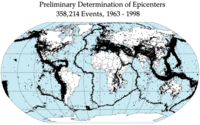
Photo from wikipedia
Rapid post-earthquake loss assessments require as input the ground motion footprint of the event. These footprints account for the geographical distribution of the seismic intensities, which, at the same time,… Click to show full abstract
Rapid post-earthquake loss assessments require as input the ground motion footprint of the event. These footprints account for the geographical distribution of the seismic intensities, which, at the same time, depend on characteristics of the event such as magnitude, location, depth, focal mechanism, and orientation of the fault plane. For most earthquakes with MW ≥ 5, moment tensor solution and, hence, the characteristics of the two nodal-planes are available. This paper proposes a simple set of rules for choosing the likely fault plane from the two nodal planes, based on a previous characterization of the seismic sources in the area under study that are commonly used in probabilistic seismic hazard analyses. With the selection of the fault plane, a critically required information for generating the parametric ground motion footprint is at hand in a matter of minutes, to be later used in the loss assessment phase. These almost real-time loss assessments are useful for different disaster risk management activities ranging from emergency planning and management to triggers of parametric insurance instruments. The application of this methodology is illustrated for three events, two in Mexico and another in Guatemala, where loss results and their geographical distributions at country level in some cases are highly sensitive to the selection of the correct nodal plane as the fault plane, showing that the proposed rules yield congruent results with the observed and recorded ground motions.
Journal Title: Natural Hazards
Year Published: 2020
Link to full text (if available)
Share on Social Media: Sign Up to like & get
recommendations!